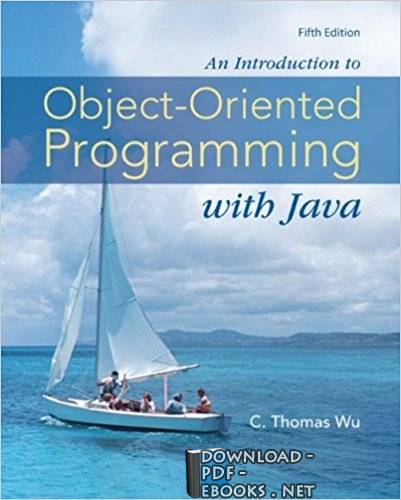📘 قراءة كتاب An Introduction to Object-Oriented Programming with Java TM أونلاين


من خلال هذه الشرائح يستفيد الدارس تعلم ماهى البرمجة الشيئية ومدى امكانياتها فى تبسيط البرمجةوذلك من خلال ما يلي :
=================================
مقدمة عن أسس لغة جافا
انواع البيانات والمنغيرات
العمليات الحسابية - عمليات الادخال والاخراج
عمليات التحكم فى البرنامج If - switch
جمل التحكم for – while
المصفوفات احادية البعد
المصفوفات ثنائية البعد
الدوال وانواعها
المصفوفات مع الدوال
الفصائل
دالة البناء
دوال زائدة التحميل
الوراثة فى الفصائل
منع التوريث ، الاجبار على التوريث
التركيب على الدوال
كلمات التحكم بالوصول الى أعضاء الفصائل
Introduction to Computers and
Programming Languages
1
0.1
A History of Computers
2
0.2
Computer Architecture
4
0.3
Programming Languages
11
0.4
Java
12
1
Introduction to Object-Oriented Programming and
Software Development
15
1.1
Classes and Objects
16
1.2
Messages and Methods
18
1.3
Class and Instance Data Values
20
1.4
Inheritance
23
1.5
Software Engineering and Software
Life Cycle
24
2
Getting Started with Java
29
2.1
The First Java Program
30
2.2
Program Components
39
2.3
Edit-Compile-Run Cycle
49
2.4
Sample Java Standard Classes
52
2.5
Sample Development
69
Contents
wu23305_fm.qxd 2/17/09 10:38 AM Page v
3
Numerical Data
85
3.1
Variables
86
3.2
Arithmetic Expressions
94
3.3
Constants
99
3.4
Displaying Numerical Values
101
3.5
Getting Numerical Input
107
3.6
The
Math
Class
113
3.7
Random Number Generation
117
3.8
The
GregorianCalendar
Class
120
3.9
Sample Development
125
3.10
Numerical Representation (
Optional
)
136
4
Defining Your Own Classes—Part 1
151
4.1
First Example: Defining and Using a Class
152
4.2
Second Example: Defining and Using Multiple Classes
162
4.3
Matching Arguments and Parameters
166
4.4
Passing Objects to a Method
168
4.5
Constructors
173
4.6
Information Hiding and Visibility Modifiers
180
4.7
Class Constants
183
4.8
Local Variables
191
4.9
Calling Methods of the Same Class
193
4.10
Changing Any Class to a Main Class
197
4.11
Sample Development
198
5
Selection Statements
221
5.1
The
if
Statement
222
5.2
Nested
if
Statements
233
5.3
Boolean Expressions and Variables
239
5.4
Comparing Objects
247
5.5
The
switch
Statement
252
5.6
Drawing Graphics
256
5.7
Enumerated Constants
266
5.8
Sample Development
272
vi
Contents
wu23305_fm.qxd 2/17/09 10:38 AM Page vi
Contents
vii
6
Repetition Statements
303
6.1
The
while
Statement
304
6.2
Pitfalls in Writing Repetition Statements
313
6.3
The
do–while
Statement
319
6.4
Loop-and-a-Half Repetition Control
323
6.5
The
for
Statement
327
6.6
Nested
for
Statements
332
6.7
Formatting Output
334
6.8
Loan Tables
339
6.9
Estimating the Execution Time
342
6.10
Recursive Methods (
Optional
)
346
6.11
Sample Development
351
7
Defining Your Own Classes—Part 2
373
7.1
Returning an Object from a Method
374
7.2
The Reserved Word
this
378
7.3
Overloaded Methods and Constructors
386
7.4
Class Variables and Methods
391
7.5
Call-by-Value Parameter Passing
395
7.6
Organizing Classes into a Package
402
7.7
Using Javadoc Comments for
Class Documentation
403
7.8
The Complete Fraction Class
408
7.9
Sample Development
418
8
Exceptions and Assertions
445
8.1
Catching Exceptions
446
8.2
Throwing Exceptions and Multiple
catch
Blocks
453
8.3
Propagating Exceptions
458
8.4
Types of Exceptions
466
8.5
Programmer-Defined Exceptions
469
8.6
Assertions
471
8.7
Sample Development
477
wu23305_fm.qxd 2/17/09 10:38 AM Page vii
viii
Contents
9
Characters and Strings
495
9.1
Characters
496
9.2
Strings
499
9.3
Pattern Matching and Regular Expression
510
9.4
The
Pattern
and
Matcher
Classes
517
9.5
Comparing Strings
521
9.6
StringBuffer
and
StringBuilder
523
9.7
String Processing and Bioinformatics
529
9.8
Sample Development
533
10
Arrays and Collections
555
10.1
Array Basics
556
10.2
Arrays of Objects
567
10.3
The For-Each Loop
577
10.4
Passing Arrays to Methods
582
10.5
Two-Dimensional Arrays
589
10.6
Lists and Maps
596
10.7
Sample Development
609
11
Sorting and Searching
633
11.1
Searching
634
11.2
Sorting
638
11.3
Heapsort
646
11.4
Sample Development
659
12
File Input and Output
685
12.1
File
and
JFileChooser
Objects
686
12.2
Low-Level File I/O
695
12.3
High-Level File I/O
700
wu23305_fm.qxd 2/17/09 10:38 AM Page viii
Contents
ix
12.4
Object I/O
709
12.5
Sample Development
716
13
Inheritance and Polymorphism
733
13.1
A Simple Example
734
13.2
Defining Classes with Inheritance
737
13.3
Using Classes Effectively with Polymorphism
741
13.4
Inheritance and Member Accessibility
744
13.5
Inheritance and Constructors
749
13.6
Abstract Superclasses and Abstract Methods
753
13.7
Inheritance versus Interface
758
13.8
Sample Development
759
14
GUI and Event-Driven Programming
787
14.1
Simple GUI I/O with
JOptionPane
790
14.2
Customizing Frame Windows
793
14.3
GUI Programming Basics
799
14.4
Text-Related GUI Components
808
14.5
Layout Managers
820
14.6
Effective Use of Nested Panels
830
14.7
Other GUI Components
839
14.8
Menus
857
14.9
Handling Mouse Events
861
object oriented programming using java pdf
object oriented programming in java شرح
java pdf عربي
introduction to java programming 10th edition pdf
introduction to java programming 9th edition pdf
oop pdf عربي
java programming pdf
java how to program
كورس جافا كامل pdf
حجم الكتاب عند التحميل : 9.6 ميجا بايت .
نوع الكتاب : pdf.
عداد القراءة:
اذا اعجبك الكتاب فضلاً اضغط على أعجبني و يمكنك تحميله من هنا:

شكرًا لمساهمتكم
شكراً لمساهمتكم معنا في الإرتقاء بمستوى المكتبة ، يمكنكم االتبليغ عن اخطاء او سوء اختيار للكتب وتصنيفها ومحتواها ، أو كتاب يُمنع نشره ، او محمي بحقوق طبع ونشر ، فضلاً قم بالتبليغ عن الكتاب المُخالف:
 قبل تحميل الكتاب ..
قبل تحميل الكتاب ..
يجب ان يتوفر لديكم برنامج تشغيل وقراءة ملفات pdf
يمكن تحميلة من هنا 'http://get.adobe.com/reader/'


 منصّة المكتبة
منصّة المكتبة